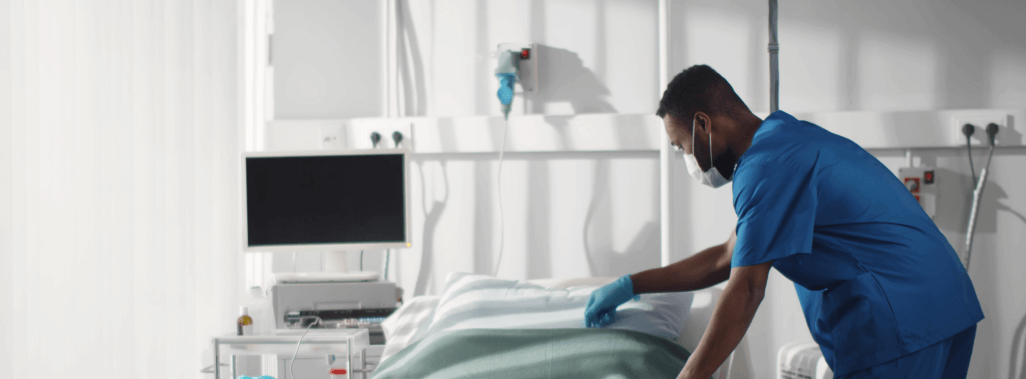Housekeeping Is Your Partner

 There are many unsung heroes in our world. In the healthcare industry, the unsung heroes are housekeepers. One may see them pushing carts around a hospital unit, putting on personal protective equipment (PPE) before entering a patient’s room, or even cleaning an elevator button. Their work is essential to exceptional patient outcomes.
There are many unsung heroes in our world. In the healthcare industry, the unsung heroes are housekeepers. One may see them pushing carts around a hospital unit, putting on personal protective equipment (PPE) before entering a patient’s room, or even cleaning an elevator button. Their work is essential to exceptional patient outcomes.
One may say, “Housekeepers do not even touch or treat patients. How could they have such an impact on patient outcomes?” Housekeepers are part of the healthcare team providing a clean, safe environment for patients, visitors, and staff. Environmental exposure to germs can lead to illness in patients and healthcare professionals (APIC, 2024). Housekeepers perform unique tasks that impact the success of healthcare delivery.
TOPICS WE WILL COVER:
1 / Preventing Healthcare-Associated Infections (HAI)
2 / Cross-Departmental Collaboration
3 / The Relationship between Housekeeper and Patient
4 / Maintaining a Clean Environment
5 / Occupational Hazards Facing Housekeeping
6 / Housekeeping Plays a Vital Role
Preventing Healthcare-Associated Infections (HAI)
Housekeepers play a role in keeping the healthcare environment clean and free from contamination. This, in turn, impacts HAI rates in healthcare. HAIs are infections that are acquired but are not present or incubating at the time of admission to a hospital. HAIs can also be discovered in ambulatory settings, such as primary care physician offices, dental clinics, and other healthcare clinics.
An example would be if an individual is admitted to a hospital due to injuries received after falling from a ladder. The individual goes through surgery and remains hospitalized for some recovery time. During that time, the individual begins to have respiratory infection symptoms and is later diagnosed with influenza (flu). The flu was not present on admission and was acquired while hospitalized.
The CDC states, “the flu virus can live on some surfaces for up to 48 hours.” Routine cleaning of surfaces may reduce the spread of flu. Cleaners and disinfectants used by housekeepers working in healthcare can kill the flu virus. It is well documented that environmental contamination in healthcare settings plays a role in transmitting HAIs. Therefore, environmental cleaning is a fundamental intervention for infection prevention and control (ICP).
In the United States, respiratory virus season typically begins in the fall. Many healthcare organizations step up the cleaning and disinfection of commonly touched surfaces during this time. The housekeeping staff may be instructed to increase cleaning protocols to decrease the transmission of respiratory viruses, such as flu, Respiratory Syncytial Virus (RSV), and COVID-19. Many other viruses, bacteria, fungi, and other pathogens live on surfaces and equipment that can easily be killed by proper cleaning and disinfection by housekeeping staff.
Cross-Departmental Collaboration
The healthcare environment is like the circulatory system in our body. It all works together as a network to help the body function optimally. All the individuals in a healthcare organization work collaboratively together to assist the patients in having a good experience.
 According to the CDC the following are all crucial program elements for effective environmental cleaning programs:
According to the CDC the following are all crucial program elements for effective environmental cleaning programs:
- Organization/Administration
- Staffing and training
- Infrastructure and supplies
- Policies and procedures
-
Monitoring, feedback, and audit
From the list above, it can be noted that a sustainable environmental cleaning program requires much more than housekeeping staff. Housekeeping leadership constantly communicates with medical staff to get discharge rooms cleaned and ready for the next patient. Operating rooms are terminally cleaned every evening to be safe and operational for surgical staff and patients the next day.
Training, budgeting, supply chain, and staffing require collaboration with the housekeeping and other departments.
The Relationship between Housekeeper and Patient
Housekeepers working in hospital settings often interact with patients more than physicians. Most of the time, housekeepers are assigned to specific floors and units, which leads them to see the same patients day after day. The interaction between the same housekeeper and patient can lead to a relationship of trust and understanding.
One article suggests that if you want to know what is wrong with a patient, ask the housekeeper assigned to clean their room. While their actual job is cleaning to create a safe environment, the relationship between the housekeeper and the patient can be immeasurable to hospital leadership: “Their [housekeeper’s] work is vital to the prevention of serious infections and the efficient running of the hospital. It’s clear they also play an important role in the care of patients” (Prose and Barfield 2020).
Maintaining a Clean Environment
Environmental cleaning and disinfection are part of the CDC’s core infection prevention and control practices for safe healthcare delivery in all settings. Housekeepers are essential in meeting this core IPC practice.
The cleaning and disinfection of healthcare settings extend to patient rooms, family waiting areas, staff lounges, locker rooms, and anywhere instruments are cleaned and sterilized for reuse, to name a few. They also may have to report to emergent cleaning situations, such as if there is blood or other potentially infectious material cleanup that needs to occur.
Housekeeping leadership assists in selecting Environmental Protection Agency (EPA) registered disinfectants that have microbicidal activity against the pathogens most likely to contaminate the patient care environment. Some hospitals have a very sterile aesthetic that serves a purpose. Furniture, wall coverings, flooring, and even the ceiling are specially selected to be easily cleanable and even to resist some microbial growth.
Special chemicals and cleaning supplies are used by housekeepers to keep the environment safe and to achieve a long life for the items being cleaned. Housekeepers in healthcare have specialized training based on the area they are assigned to clean. In addition, they are taught to follow the manufacturers’ instructions for use (IFU) for proper use of cleaning and disinfecting products.
Occupational Hazards Facing Housekeeping
The world learned from the COVID-19 pandemic that healthcare workers are not the only ones at risk of illness in healthcare settings. Infectious diseases and pathogens can be transmitted to anyone involved with the infected patient and the patient's surroundings.
The Occupational Safety and Health Administration (OSHA) recognizes the hazards that housekeeping staff are exposed to, to name a few:
- Influenza
- Norovirus
- Ebola
- Middle East Respiratory Syndrome (MERS)
- Tuberculosis
- Methicillin-resistant Staphylococcus Aureus (MRSA)
There is also the risk of any bloodborne pathogen exposure that could lead to illness. Some of the proper measures to prevent infection might include using PPE (such as gloves), washing hands, cleaning work surfaces, and properly disposing of sharps. Some housekeeping staff are responsible for the proper disposal of regulated medical waste. This waste may be contaminated by blood, body fluids, or other potentially infectious materials. This requires special training in handling and proper disposal.
Housekeeping Plays a Vital Role
Infection prevention and control is everyone’s business. The healthcare team must collaborate to create and maintain a safe environment. Housekeepers in healthcare are often overlooked in this team and hold an important role. Next time you see a housekeeper working in healthcare, thank them for keeping us all safe.
References:
- APIC. 2024. Environmental Services. https://apic.org/Resources/Topic-specific-infection-prevention/Environmental-services/
- CDC. HAI. Best practices for environmental cleaning in healthcare. https://r.search.yahoo.com/_ylt=Awr48GwpQgxmCWMEpT5XNyoA;_ylu=Y29sbwNncTEEcG9zAzQEdnRpZAMEc2VjA3Ny/RV=2/RE=1713289001/RO=10/RU=https%3a%2f%2fwww.cdc.gov%2fhai%2fpdfs%2fresource-limited%2fenvironmental-cleaning-RLS-H.pdf/RK=2/RS=KuFrrq3bw1j0bKj68W.ht8WcPmM-
- CDC. HAI. Environmental cleaning supplies and equipment. https://www.cdc.gov/hai/prevent/resource-limited/supplies-equipment.html
- CDC. Infection Control. CDC’s core infection prevention and control practices for safe healthcare delivery in all settings. https://www.cdc.gov/infectioncontrol/guidelines/core-practices/index.html
- Prose, Neil; Barfield, Ray. STAT. In hospitals, housekeepers are truly the ‘keepers of the house.’ https://www.statnews.com/2020/02/05/hospital-housekeepers-truly-keepers-of-the-house/
- US Department of Labor-Occupational Safety and Health Administration [OSHA]. Housekeeping. https://www.osha.gov/etools/hospitals/housekeeping
